 Facebook
Facebook
 X
X
 Instagram
Instagram
 TikTok
TikTok
 Youtube
Youtube
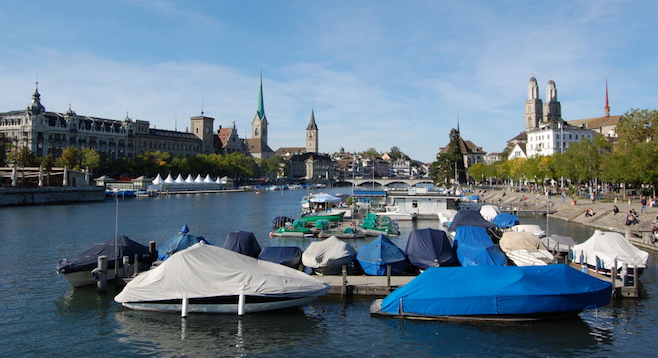
The Economist ranks Switzerland the best country “to be born in 2013.” Zürich, the largest Swiss metropolis with 380,000 residents, has been voted the planet’s best city by Mercer Human Resource Consulting, Monocle and others. Why?
Surrounded by France, Germany, Italy and Austria, Switzerland is technically landlocked; but considering the mountainous country’s many lakes, it’s arguably a nautical nation. To make a grand entrance into the so-called “Little Big City” at the northwestern end of Lake Zürich, I board a boat that provides the most picturesque mass transit this side of the Staten Island Ferry. Skipping the trains for this less fleet-of-foot fleet, I take my time in the land of Swiss precision timing. The ferry crosses Zürichsee, Switzerland’s sixth-largest lake, embraced by the Alps.
As I bask on deck in the summer sunshine, we float past villages hugging the lake such as Rapperswil, with its 13th-century castle. Nearing the harbor, Zürich’s medieval-and-modern skyline beckons.
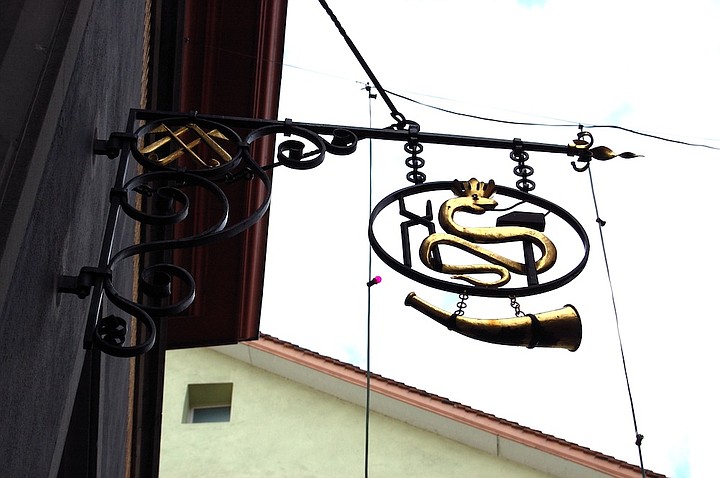
The blood-red Swiss flag with its white cross flaps in the breeze as the ferry punctually wafts into Bürkliplatz. Disembarking as streetcars roll by, I promenade down Bahnhofstrasse, Europe’s “most expensive street,” strolling past the five-star Baur au Lac, jewelers, high-end boutiques, banks, sweet shops and cafes such as Sprüngli, an oasis of hoity-toity hot chocolate. On the other side of the Bahnhof, Switerzland’s Grand Central Station, is my first destination.
Designed in the late 19th century, Landesmuseum Zürich houses collections showcasing the Confederation’s patrimony, including coins, timepieces and dioramas of knights doing battle. So I’m surprised by the summer’s thought-provoking “Postmodernism, Style and Subversion 1970–1990” exhibition focusing on the dystopian, cynical aesthetic that rejected modernism’s utopianism. The multimedia installation includes interior design, imagery, fashion and music, with way-out wacky chairs, Warhol’s Mao sketch, Grace Jones’ triangular dress, a Boy George hologram. In a faux disco visitors can play DJ, selecting which music video is screened.
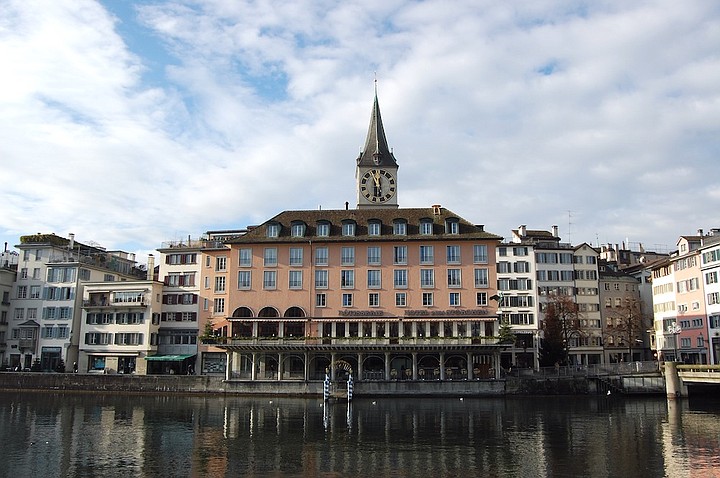
Landesmuseum is beside the Limmat River, where sleek motorized crafts with glass-enclosed cabins depart for hour-long jaunts zigzagging across the river. En route, we glide through glorious Altstadt, or Old Town, stretching along both banks.
Largely spared fires and wars, peaceful Switzerland sports some of Europe’s best surviving medieval architecture. The boat wafts past guild houses – established by trade associations in the Middle Ages, they’re social clubs today – passing Zunft Zum Kämbel, the food dealers and wine merchants’ guild, bearing a plaque with a golden camel and half moon, plus the carpenters’ “House of the Red Eagle,” with its distinctive peaked red roof and upstairs fine dining restaurant Zunfthaus Zur Zimmerleuten.

Old Town’s main cathedrals are also visible: Fraumünster, famed for Marc Chagall’s stained glass windows; twin-towered Grossmünster, founded in the 12th century by Charlemagne, whose enthroned, crowned, sword-wielding image is sculpted into the southern tower and onto a bronze door; and St. Peter, boasting Europe’s largest clock face. As the boat nears Zürichsee we move from the sacred to the profane, as topless women insouciantly lounge at a ladies’ swim club while swans frolic in the water.
Ambling about Old Town is my favorite thing to do in Zürich, so I stay at the Widder Hotel in Altstadt, near Bahnhofstrasse. Its rooftop offers a 360-degree view of medieval and modern Zürich. A marvel of design, the Widder is composed from nine age-old townhouses built as far back as 1066, artfully unified into a single property by Swiss architect Tilla Theus. Classic meets contemporary: wooden beams, mouth-blown window glass and 13th-century ornately painted ceilings commingle with Giacomettis, Rauschenbergs, Warhols, Corbusier recliners, Frank Lloyd Wright furniture, a glass-enclosed elevator and techno-gym.
The five-star offers free mini-bars and espresso machines in each of its 49 units. Its Library of Spirits has 400 whiskeys and a pianist. Morning repasts are served in the airy Breakfast Pavilion, complete with a glass ceiling.
My spacious suite features a multi-head thalasso shower and high-tech CD player. Service is always lickety-split, proving the Widder’s watchword: “At home in Zürich.”
During my Widder stay I trek along Zürichsee to Wollishofen to behold Theater Spektakel, an annual outdoor happening of international cutting-edge performances. Bangkok’s Pichet Klunchun Dance Company combines Thai and avant-garde choreography with athleticism. While they're dancing lakeside onstage, it starts to pour, but in that “show must go on!” tradition, the hoofers continue without missing a beat.
Too rainy to walk to the hotel, I dash aboard a departing vessel, which crosses the lake instead of returning to Zürich. Upon disembarking I hop onto a tram bound towards the Widder, wetter but wiser.
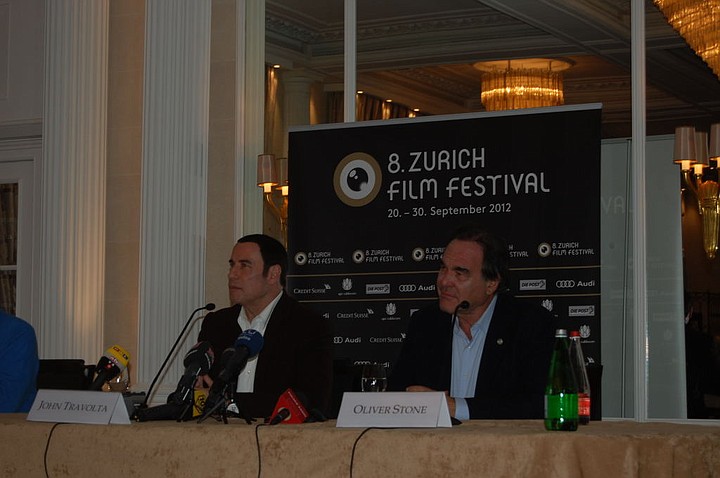
In September I cover the 8th-annual Zürich Film Festival, headquartered near the 19th-century opera house. Oliver Stone’s Savages launches the film fest. At a press conference with John Travolta – recipient of ZFF’s Lifetime Achievement Award – in the Baur au Lac (left), I ask the antiwar Platoon director how it feels to be in a country that hasn’t fought a war for 164 years.
Herein lies the explanation why Swiss babies are Earth’s luckiest and Zürich is so stellar.
I lunch with Green Party parliamentarian Alec von Graffenried in Clouds, a splendid restaurant atop Switzerland’s tallest building, Prime Tower, located in Zürich West, a former factory district converted into a trendy, artsy shopping and dining area. Discussing the Swiss military budget, von Graffenried says it’s 3% of government expenditures – and that he wants to cut it.
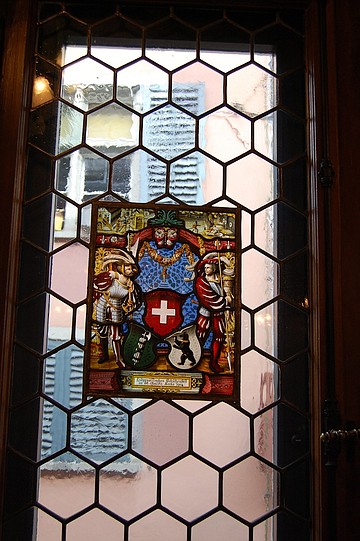
Switzerland’s prosperity owes at least as much to its neutrality policy as to those secretive banking laws. Excluding the Vatican, Swiss mercenaries are long gone.
If a country doesn’t bankrupt itself on empire and endless wars, it has money for preserving nature, culture, mass transit, citizens’ needs. Minus militarism and a violence-obsessed culture, people can live crime-free in peace; children can go to school to learn – instead of shot at.


The Economist ranks Switzerland the best country “to be born in 2013.” Zürich, the largest Swiss metropolis with 380,000 residents, has been voted the planet’s best city by Mercer Human Resource Consulting, Monocle and others. Why?
Surrounded by France, Germany, Italy and Austria, Switzerland is technically landlocked; but considering the mountainous country’s many lakes, it’s arguably a nautical nation. To make a grand entrance into the so-called “Little Big City” at the northwestern end of Lake Zürich, I board a boat that provides the most picturesque mass transit this side of the Staten Island Ferry. Skipping the trains for this less fleet-of-foot fleet, I take my time in the land of Swiss precision timing. The ferry crosses Zürichsee, Switzerland’s sixth-largest lake, embraced by the Alps.
As I bask on deck in the summer sunshine, we float past villages hugging the lake such as Rapperswil, with its 13th-century castle. Nearing the harbor, Zürich’s medieval-and-modern skyline beckons.

The blood-red Swiss flag with its white cross flaps in the breeze as the ferry punctually wafts into Bürkliplatz. Disembarking as streetcars roll by, I promenade down Bahnhofstrasse, Europe’s “most expensive street,” strolling past the five-star Baur au Lac, jewelers, high-end boutiques, banks, sweet shops and cafes such as Sprüngli, an oasis of hoity-toity hot chocolate. On the other side of the Bahnhof, Switerzland’s Grand Central Station, is my first destination.
Designed in the late 19th century, Landesmuseum Zürich houses collections showcasing the Confederation’s patrimony, including coins, timepieces and dioramas of knights doing battle. So I’m surprised by the summer’s thought-provoking “Postmodernism, Style and Subversion 1970–1990” exhibition focusing on the dystopian, cynical aesthetic that rejected modernism’s utopianism. The multimedia installation includes interior design, imagery, fashion and music, with way-out wacky chairs, Warhol’s Mao sketch, Grace Jones’ triangular dress, a Boy George hologram. In a faux disco visitors can play DJ, selecting which music video is screened.

Landesmuseum is beside the Limmat River, where sleek motorized crafts with glass-enclosed cabins depart for hour-long jaunts zigzagging across the river. En route, we glide through glorious Altstadt, or Old Town, stretching along both banks.
Largely spared fires and wars, peaceful Switzerland sports some of Europe’s best surviving medieval architecture. The boat wafts past guild houses – established by trade associations in the Middle Ages, they’re social clubs today – passing Zunft Zum Kämbel, the food dealers and wine merchants’ guild, bearing a plaque with a golden camel and half moon, plus the carpenters’ “House of the Red Eagle,” with its distinctive peaked red roof and upstairs fine dining restaurant Zunfthaus Zur Zimmerleuten.

Old Town’s main cathedrals are also visible: Fraumünster, famed for Marc Chagall’s stained glass windows; twin-towered Grossmünster, founded in the 12th century by Charlemagne, whose enthroned, crowned, sword-wielding image is sculpted into the southern tower and onto a bronze door; and St. Peter, boasting Europe’s largest clock face. As the boat nears Zürichsee we move from the sacred to the profane, as topless women insouciantly lounge at a ladies’ swim club while swans frolic in the water.
Ambling about Old Town is my favorite thing to do in Zürich, so I stay at the Widder Hotel in Altstadt, near Bahnhofstrasse. Its rooftop offers a 360-degree view of medieval and modern Zürich. A marvel of design, the Widder is composed from nine age-old townhouses built as far back as 1066, artfully unified into a single property by Swiss architect Tilla Theus. Classic meets contemporary: wooden beams, mouth-blown window glass and 13th-century ornately painted ceilings commingle with Giacomettis, Rauschenbergs, Warhols, Corbusier recliners, Frank Lloyd Wright furniture, a glass-enclosed elevator and techno-gym.
The five-star offers free mini-bars and espresso machines in each of its 49 units. Its Library of Spirits has 400 whiskeys and a pianist. Morning repasts are served in the airy Breakfast Pavilion, complete with a glass ceiling.
My spacious suite features a multi-head thalasso shower and high-tech CD player. Service is always lickety-split, proving the Widder’s watchword: “At home in Zürich.”
During my Widder stay I trek along Zürichsee to Wollishofen to behold Theater Spektakel, an annual outdoor happening of international cutting-edge performances. Bangkok’s Pichet Klunchun Dance Company combines Thai and avant-garde choreography with athleticism. While they're dancing lakeside onstage, it starts to pour, but in that “show must go on!” tradition, the hoofers continue without missing a beat.
Too rainy to walk to the hotel, I dash aboard a departing vessel, which crosses the lake instead of returning to Zürich. Upon disembarking I hop onto a tram bound towards the Widder, wetter but wiser.

In September I cover the 8th-annual Zürich Film Festival, headquartered near the 19th-century opera house. Oliver Stone’s Savages launches the film fest. At a press conference with John Travolta – recipient of ZFF’s Lifetime Achievement Award – in the Baur au Lac (left), I ask the antiwar Platoon director how it feels to be in a country that hasn’t fought a war for 164 years.
Herein lies the explanation why Swiss babies are Earth’s luckiest and Zürich is so stellar.
I lunch with Green Party parliamentarian Alec von Graffenried in Clouds, a splendid restaurant atop Switzerland’s tallest building, Prime Tower, located in Zürich West, a former factory district converted into a trendy, artsy shopping and dining area. Discussing the Swiss military budget, von Graffenried says it’s 3% of government expenditures – and that he wants to cut it.

Switzerland’s prosperity owes at least as much to its neutrality policy as to those secretive banking laws. Excluding the Vatican, Swiss mercenaries are long gone.
If a country doesn’t bankrupt itself on empire and endless wars, it has money for preserving nature, culture, mass transit, citizens’ needs. Minus militarism and a violence-obsessed culture, people can live crime-free in peace; children can go to school to learn – instead of shot at.
Comments